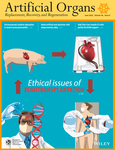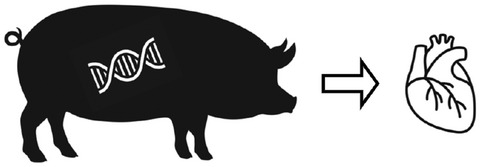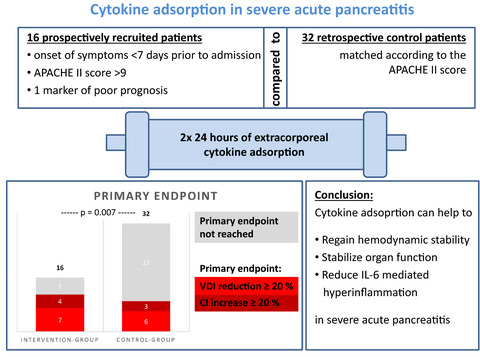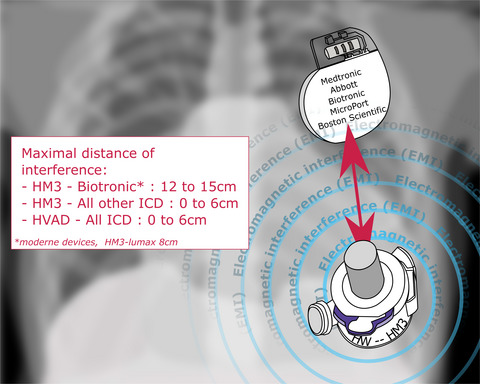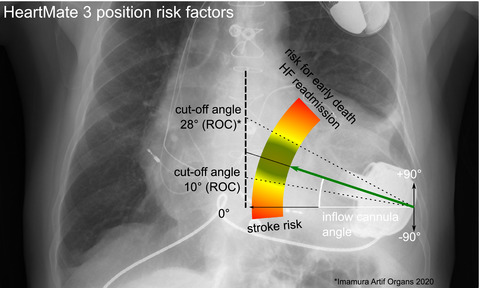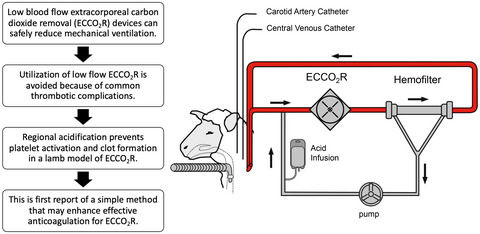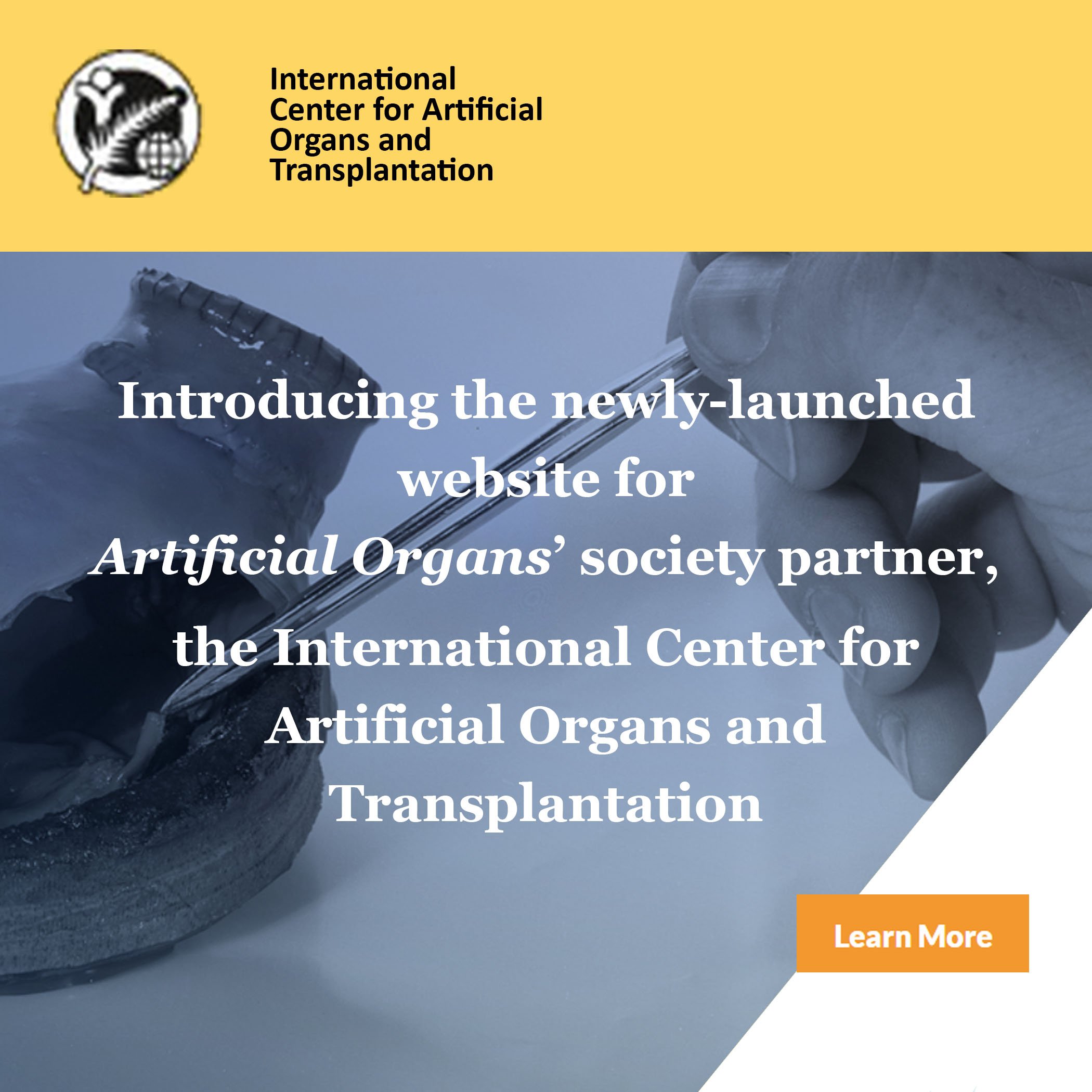Journal list menu
Export Citations
Download PDFs
COVER IMAGE
Cover Image
- Page: i
- First Published: 18 May 2022
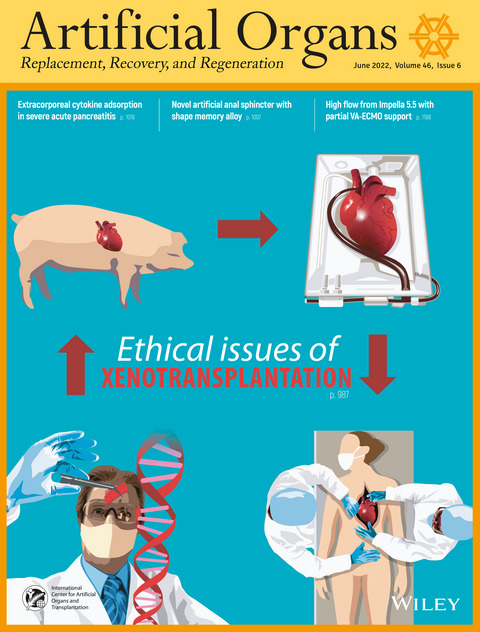
The concept of xenotransplantation is very complex. It made most sense to show this as a step-by-step cycle in this illustration: Initially, a scientist edits the DNA structure. Next, the heart destined for transplantation grows in the genetically modified pig. After procurement, the heart is perfused to assess it and get it ready for surgery. The implantation of the heart into a human completes the cycle. While somewhat simplified, the schematic captures the complexity of xenotransplantation and related ethical issues.
ISSUE INFORMATION
NEWS
IN BRIEF
IN FOCUS
A man in a completely locked-in state produces intelligible sentences using a brain-computer interface
- Pages: 985-986
- First Published: 25 April 2022
INVITED REVIEW
Clinical xenotransplantation seems close: Ethical issues persist
- Pages: 987-994
- First Published: 22 April 2022
INVITED COMMENTARY
REVIEW
Strategies for optimizing urea removal to enable portable kidney dialysis: A reappraisal
- Pages: 997-1011
- First Published: 06 April 2022
SYSTEMATIC REVIEW
Impact of third-generation left ventricular assist devices on quality of life: Scoping review and meta-analysis
- Pages: 1012-1018
- First Published: 07 February 2022

- The use of third-generation left ventricular assist devices confer a significant improvement in quality of life.
- These outcomes are a useful tool in patient selection and the decision-making process for left ventricular assist device implantation.
- The role of quality of life assessment in future trials is important.
CLINICAL TRIAL
Influence of extracorporeal cytokine adsorption on hemodynamics in severe acute pancreatitis: Results of the matched cohort pancreatitis cytosorbents inflammatory cytokine removal (PACIFIC) study
- Pages: 1019-1026
- First Published: 19 February 2022
MAIN TEXT
The effect of blood viscosity on shear-induced hemolysis using a magnetically levitated shearing device
- Pages: 1027-1039
- First Published: 14 January 2022
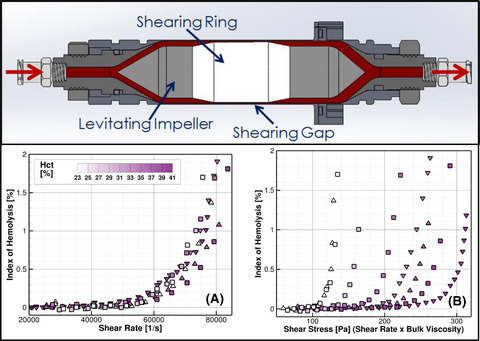
We investigated hemolysis in a magnetically levitated axial Couette flow device typical of a rotary VAD over a controlled range of shear rate. The Index of Hemolysis was a function of shear rate, yet largely independent of hematocrit, bulk viscosity, or the suspension media viscosity. We recommended that future investigations of shear-induced blood damage report findings with respect to the viscosity-neutral term of shear rate, in addition to the bulk whole blood viscosity measured at an appropriate shear rate.
Bioengineering of fibroblast-conditioned polycaprolactone/gelatin electrospun scaffold for skin tissue engineering
- Pages: 1040-1054
- First Published: 10 January 2022
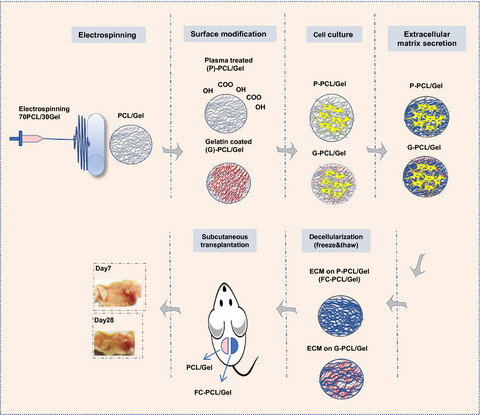
This study presents a cell-secreted ECM-conditioned PCL electrospun scaffolds with improved biomechanical and biological properties for bioengineering of skin wound dressing. The scaffold is modified by coating or plasma treatment, and the cells are cultured on the scaffolds. Finally, the cells/scaffold constructs are decellularized by an optimized decellularization with complete removal of the cells and minimal elimination of the secreted ECM. The ECM-conditioned PCL mat shows improved hydrophilic properties with enhanced biocompatibility and angiogenic properties in vitro and in vivo.
Impact of adaptive gastric electrical stimulation on weight, food intake, and food intake rate in dogs
- Pages: 1055-1067
- First Published: 21 December 2021
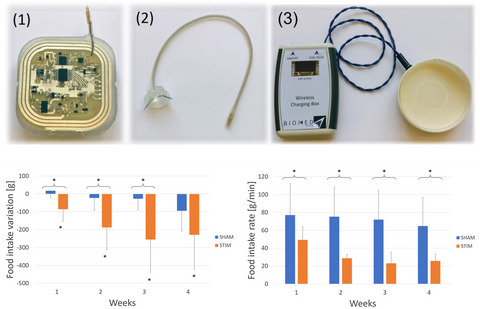
Using an adaptive gastric electrical stimulation protocol which increases the stimulation energy proportionally to the excess of food intake in dogs, we obtained:
- - A significant decrease of food intake with respect to baseline (−42% by week 4).
- - A significant decrease of food intake rate during the STIM period compared to the SHAM (−60% at week 4).
- - A significant increase of the postprandial frequency of the gastric slow waves (+11% STIM vs. SHAM), as measured with a noninvasive cutaneous system.
Hemodynamics of small arterial return cannulae for venoarterial extracorporeal membrane oxygenation
- Pages: 1068-1076
- First Published: 20 January 2022
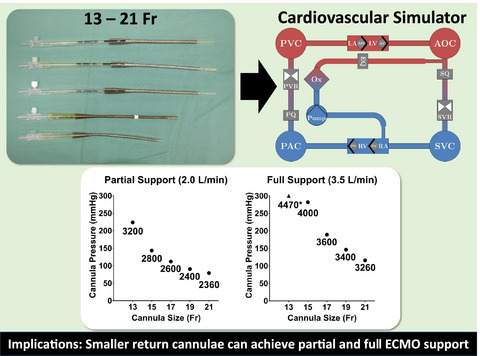
Smaller extracorporeal membrane oxygenation cannulae provided targeted partial and full support in a mechanical cardiovascular simulator with minimal differences in patient hemodynamics but exponential changes in arterial cannula inlet pressures. AOC, PAC – Aortic and pulmonary arterial compliance chambers; SVC, PVC – Systemic and pulmonary venous compliance chambers; LV, RV, LA, RA – Left and right ventricles and atria; AV, MV, PV, TV – Aortic, mitral, pulmonary, and tricuspid valves; SVR, PVR – lumped systemic and pulmonary vascular resistance; SQ, PQ, EQ – Systemic, pulmonary, and ECMO flow meters; Pump, Ox – ECMO blood pump and oxygenator.
Dynamic pressure—flow curve analysis of the native heart and left ventricular assist device for full and partial bypass conditions
- Pages: 1077-1085
- First Published: 21 December 2021
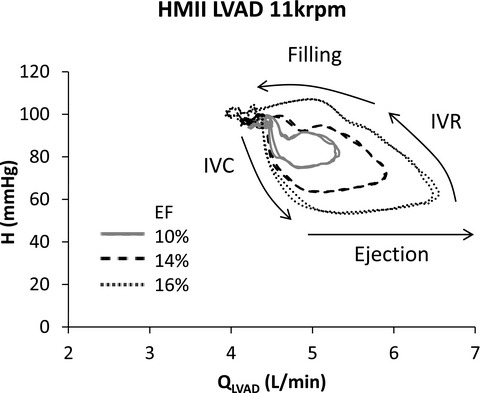
A balance of work was derived from dynamic pressure-flow measurements of the native left ventricle and HeartMate II LVAD for both full and partial bypass conditions. The area enclosed by the counterclockwise H–Q loops increased with ejection fraction shifted position with LVAD speed. Partial bypass conditions produced systolic flow through the aortic valve which was accompanied by energy reduction during the rest of the cardiac cycle. The additional terms added to the external work balance provides a validated theory for use in LVAD design and control to assess a wide range of patient-specific conditions.
Contribution of diafiltration and adsorption to vancomycin clearance in a continuous hemodiafiltration circuit model in vitro
- Pages: 1086-1096
- First Published: 20 January 2022
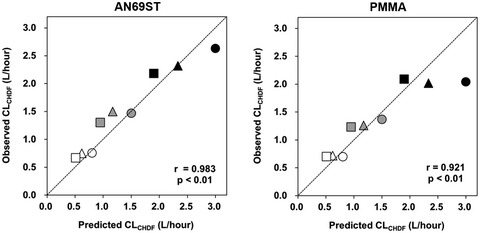
The contribution of diafiltration and adsorption to continuous hemodiafiltration clearance (CLCHDF) of vancomycin (VCM) using a polyacrylonitrile and sodium methallyl sulfonate copolymer membrane coated with polyethylenimine (AN69ST) or a polymethylmethacrylate (PMMA) membrane was investigated. Diafiltration predominantly contributed to CLCHDF of VCM using AN69ST and PMMA membranes. When diafiltration rather than adsorption mainly contributes to the CLCHDF of VCM, the CLCHDF could be predicted from the effluent flow rate and serum albumin level, at least in vitro.
Experimental assessment of a novel artificial anal sphincter with shape memory alloy
- Pages: 1097-1106
- First Published: 21 January 2022
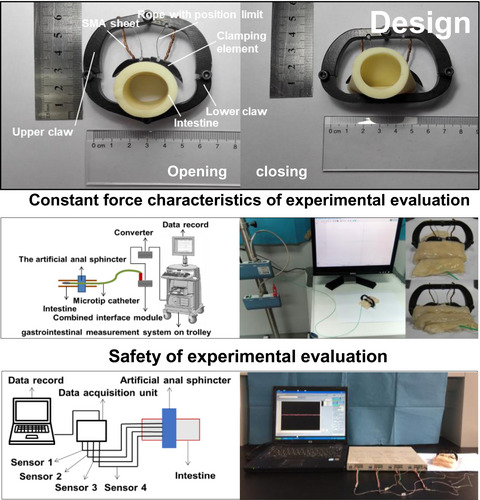
- The biomechanical compatibility of artificial anal sphincter and intestinal tissue is a key issue in clinical application of artificial anal sphincter.
- This paper presented a design of an artificial anal sphincter with constant force.
- The constant force properties and safety of this novel device was evaluated by experiment conducted in pig intestine with various thicknesses.
- The safety of the artificial anal sphincter was verified by testing the surface contact stress of pig intestine under the clamping of artificial anal sphincter.
Intraosseous infusion of liposome-encapsulated hemoglobin (HbV) acutely prevents hemorrhagic anemia-induced lethal arrhythmias, and its efficacy persists with preventing proarrhythmic side effects in the subacute phase of severe hemodilution model
- Pages: 1107-1121
- First Published: 10 January 2022

HbV has sustained antiarrhythmic effect in 85% hemodilution model by ameliorating electrical remodeling and improving arrhythmogenic modifying factors such as cardiac autonomic function, left ventricular function and spontaneous ventricular arrhythmias in subacute phase. These findings are useful in now conduction clinical trial of HbV.
A mathematical estimation for quantified calcium supplementation during intermittent hemodialysis using regional citrate anticoagulation
- Pages: 1122-1131
- First Published: 03 January 2022
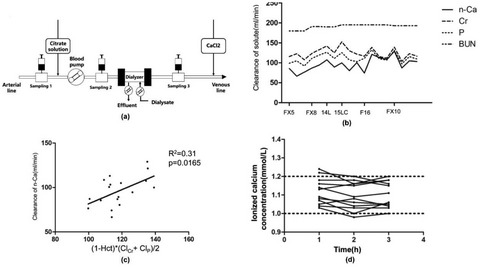
Calcium supplementation is important for safety of regional citrate anticoagulation. In this study, we proposed a mathematical model including various types of filters based on the clearance of creatinine, phosphate and calcium for estimation of calcium supplementation during RCA-IHD. We also validated our model in 12 sessions of intermittent hemodialysis. (A) Dialysis circuit for intermittent hemodialysis using regional citrate anticoagulation (RCA). (B) Comparison of the actual clearance of n-Ca with the clearance of BUN and the hematocrit-adjusted clearance of creatinine and phosphate given in the dialyzer leaflet. (C) Linear regression analysis of the actual clearance of n-Ca. (D) The changes of ionized calcium levels during hemodialysis with guidance of the mathematical model during the treatment.
Importance of electromagnetic interactions between ICD and VAD devices—Mechanistic assessment
- Pages: 1132-1141
- First Published: 03 January 2022
Early detection of HVAD pump thrombosis based on technical analysis and power consumption measurements
- Pages: 1142-1148
- First Published: 03 January 2022
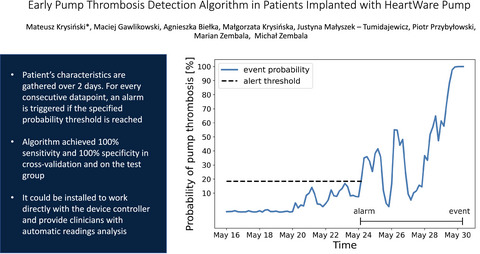
- Patient's characteristics are gathered over 2 days. For every consecutive datapoint, an alarm is triggered if the specified probability threshold is reached.
- Algorithm achieved 100% sensitivity and 100% specificity in cross-validation and on the test group.
- It could be installed to work directly with the device controller and provide clinicians with automatic readings analysis.
Inflow cannula position as risk factor for stroke in patients with HeartMate 3 left ventricular assist devices
- Pages: 1149-1157
- First Published: 03 January 2022
Risk factors associated with in-hospital mortality for patients with ECLS due to postcardiotomy cardiogenic shock after isolated coronary surgery
- Pages: 1158-1164
- First Published: 05 January 2022
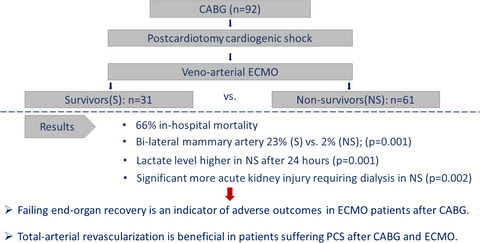
Mortality in patients with refractory PCS after CABG and consecutive ECLS treatment remains high. Failing end-organ recovery under ECLS support despite optimized concomitant medical therapy is an indicator of adverse outcomes in this specific patient cohort. Moreover, total-arterial revascularization might be beneficial for cardiac recovery in patients suffering PCS after CABG and following ECLS treatment.
Psychological burden and coping in destination therapy patients with a left ventricular assist device: A qualitative content analysis
- Pages: 1165-1180
- First Published: 21 December 2021
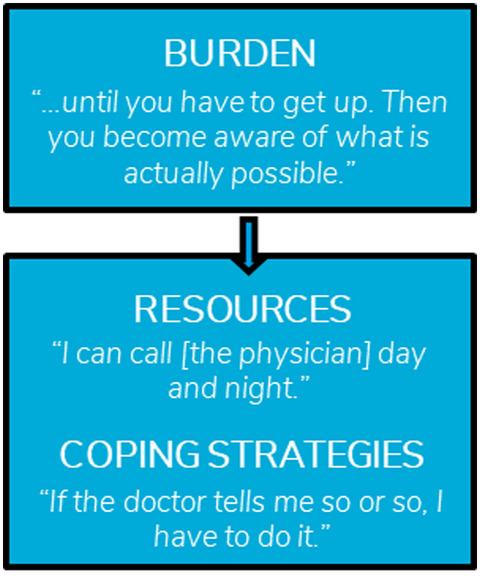
This qualitative study addresses the relatively new question of burden and coping in left ventricular assist device patients. Interviews with 18 destination therapy patients were analyzed using an inductive content analysis. The results highlight 10 psychosocial, health and treatment-related burdens, 15 problem-and emotion-focused coping strategies and 5 resources used for coping. Implications for future research and clinical practice are developed. For example, certain health care aspects play a decisive role for psychosocial and clinical outcomes that have rarely been researched before.
THOUGHTS & PROGRESS
Regional blood acidification inhibits coagulation during extracorporeal carbon dioxide removal (ECCO2R)
- Pages: 1181-1191
- First Published: 15 March 2022
HISTORY
Zirconium cyclosilicate: An oral sorbent for potassium, four decades in the making
- Pages: 1192-1197
- First Published: 19 April 2022
CASE SERIES
High flow from Impella 5.5 with partial veno-arterial extracorporeal membrane oxygenation support: Case series
- Pages: 1198-1203
- First Published: 02 February 2022
CONFERENCE REPORT
Highlights from the Transcatheter Cardiovascular Therapeutics 2021 meeting
- Pages: 1204-1208
- First Published: 17 April 2022
LETTER TO THE EDITOR
Will xenotransplantation be the death knell for brain death?
- Pages: 1209-1210
- First Published: 22 April 2022




